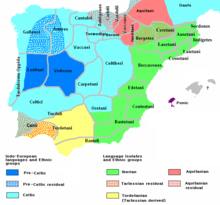





The Ilercavones were an ancient Iberian (Pre-Roman) people of the Iberian peninsula (the Roman Hispania). They are believed to have spoken an Iberian language.
The name Ilercavonia to refer to the territory occupied by this Iberian tribe appears in ancient Greek and Roman texts and documents and it was still mentioned in medieval texts.[1] The northern limits of this territory were in Serra de la Llena, the northeastern in Coll de Balaguer, the western in Mequinensa and the southern in Sagunt.
The Ilercavones were very religious as a people. They did not have temples, but every mountain or hill was considered a sacred place.[2] The Ilercavones as a nation or tribe were already mentioned by Pliny the Elder, who said that they inhabited the lands between river Udiva (possibly the Millars River) and further north of the Ebro, and by Ptolemy, who named the cape and the harbor where they lived Tenebri (possibly Orpesa). They were mentioned as well as by Livy in his texts describing the first phase of the Roman invasion of Iberia.
After the Roman conquest the Ilercavones became romanized, much like the other Iberian tribes in the peninsula. Gradually, they became assimilated into the Roman population, especially after acquiring the Latin language as their own vernacular.[3]
The most important archaeological sites are in the following places:
|
| |||||||
|---|---|---|---|---|---|---|---|
| Aquitani (Proto-Basques) |
| ||||||
| Iberians |
| ||||||
| Celts |
| ||||||
| Para-Celtic peoples? |
| ||||||
| Germanic peoples? |
| ||||||
| Greeks |
| ||||||
| Semitic peoples |
| ||||||
The Madeira, Azores, and Canary Islands were not occupied by the Romans. The Madeira and Azores islands were unoccupied until the Portuguese in the 15th century; the Canary islands, the Guanches occupied the territory until the Castilians. | |||||||
This article about an ethnic group in Europe is a stub. You can help Wikipedia by expanding it. |
This Spanish history–related article is a stub. You can help Wikipedia by expanding it. |